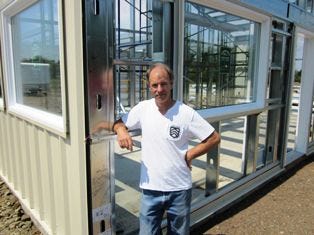There are many hurdles to building a self-storage facility, and one of the biggest is gaining the approval of the local zoning board. Developers and owners who are well prepared going into the process will have an easier time gaining their boards approval.
September 4, 2013

By Marc Goodin
Youve found a piece of land and the only thing standing between you and your dream of building a self-storage facility is getting your approvals from the town. Were always hearing about the projects that are rejected, but after 30 years as a civil engineer designing self-storage sites, including the three I own, I can personally attest that the vast majority are approved.
However, if you dont do your homework, you could be stopped dead in your tracks. Fortunately, if youre prepared and ready to answer just about any question or concern your towns zoning department may have, more often than not, youll gain their support.
Understand the Regulations
The first step in being prepared for approval is having complete plans that meet the zoning regulations. Revisions during the process cause delays and are often expensive. Educate yourself on the planning and zoning regulations and wetland regulations for the area in which youd like to build. You can often find this information online or buy it at city hall.
Some towns have incredibly detailed self-storage regulations while others have the same regulations for self-storage and general commercial. Dont forget that in addition to industry-specific guidelines there are many other general regulations that must be met by all commercial developments. Most new developers get in trouble by making many wrong assumptions because they were not aware of all the parameters.
 Here are just a few zoning regulations Ive come across that can have a major impact on your facilitys design or approval. Anyone of these (and many others) can require substantially more land or money than originally anticipated, so be prepared.
Here are just a few zoning regulations Ive come across that can have a major impact on your facilitys design or approval. Anyone of these (and many others) can require substantially more land or money than originally anticipated, so be prepared.
No self-storage can be located within three miles of another storage facility.
The maximum property coverage of the storage buildings and pavement is 50 percent.
Self-storage can only be located in the industrial park zone.
Only one building is permitted on a single parcel.
No development or restricted development is permitted within 150 feet of the wetlands.
One parking space is required per 1,000 square feet of building.
Onsite drainage detention is required, which takes large areas of land to build.
Similarly, new developers often dont conduct a review of the building codes and other self-storage standards before they start their design plans. This can lead to poor design or even significant redesigns. For example, here are three non-zoning codes that are often initially overlooked:
Some fire codes or building codes can overrule zoning codes for driveway widths, requiring 30 feet between buildings.
Building-code firewall requirements should also be reviewed prior to completing your site plan. Sometimes you can save money by eliminating expensive firewalls and limiting individual building sizes.
Building widths of 10 feet increments are more cost-efficient because theres less waste.
Meet With City Staff
How you communicate and present your project will have a major impact on your zoning departments support as well. Yes, its politics. Early in the process, you want to meet with the city planner and engineer to learn more about the regulations and start building a rapport with them. Specifically ask for recommendations they may have as you move forward.
After you have a conceptual plan, its time to meet with them again. Dont wait until youve completed expensive site plans by your engineer only to find youve overlooked something buried deep in the regulations or unwritten guidelines or requirements.
Its beneficial for the city staff to be in favor of your project, but beware the votes that count are the regulatory commissioners votes. Always be over prepared for every regulatory meeting. Have all your guns ready! Often the only reason I have won approval against large crowds of opposition was because I was over prepared.
Polish Your Presentation
Bring your design team including your civil engineer, landscape designer, traffic engineer, architect and attorney (if customary in your town) to the zoning meeting. A single presenter can do the majority, if not the entire presentation, if everything goes smoothly. As the owner, you must attend all the meetings. End the presentation by letting the commission know youre happy your design team did such a great job and you look forward to being a part of the community. Always thank the commission members for their time.
Be prepared to make concessions the night of the meeting if necessary to get an approval. You might have to rebuff the many myths about self-storage such as noise, drugs, low value, no taxes, people living in units, used mostly by people from out of town, ugly, self-storage does not mix with residential uses, high traffic, etc.
As the owner, you need to be the expert. Know your facilitys policy on prohibition of storage of hazardous materials. Have a copy of your lease prohibiting hazardous materials in case the topic comes up. Provide a copy of the sign that will be posted in your office and front gate prohibiting hazardous materials. Give an explanation that includes how youll know your customers, such as a copy of every renters driver license, home and work numbers, e-mail addresses, a second contact person, etc.
An explanation in detail of how the staff is required to walk and inspect the site several times a day can help give the commission confidence that there will not be any problems at your facility. Let them know how many security cameras your facility will employ.
Pictures are a tremendous help. Have them on a presentation board and an extra set to hand to the commission members to view. Include pictures of site signage such as smile for our cameras, and images of your security cameras, security gate and keypad, and office-monitoring screen.
Handle the Rebuttals
More than once Ive had to respectively object to a towns request to block the view of a storage facility with a row or two of pine trees. Just as a grocery store or another business in town would not survive if hidden from view, neither could a self-storage business. But your rendering elevation view from the street should show how youve set your buildings back a couple of extra feet and provided more landscaping than required by the regulations. This might include a couple of pine trees to break up the view, several trees, flowering bushing and slightly raised flower beds. Landscaping is money well spent. The No. 1 reason people are going to choose your facility over your competition is the pleasing view of your facility from the street when they drive by.
Lighting is often a concern. Light photometrics should be available to show the light from your facility will not impact neighbors. LED lights cost more to install but will pay for themselves in a short time and save you money for many years.
While many things should not be part of the commissions decision process, they sometimes are. Know your marketing study so you can explain the need for self-storage in the area. Let them know its a benefit to the community, as most of your customers will be the people within five miles or less of your property.
Traffic is often an unwarranted concern you must be prepared to rebuff. If the town didnt require a traffic study as part of your application I recommend you have at least a simple one-page summary for the projected daily and peak-hour traffic generation, and a comparison to other uses. Self-storage is one of the lowest traffic generators and has less traffic than typical retail, office, businesses and even a residential subdivision.
While there are many hurdles to building a self-storage facility, getting the approval of the local zoning board can sometimes be one of the biggest challenges. Be prepared by learning early on about zoning requirements, hiccups you might face and potential objections from zoning board members. By doing so, youll gain support and be one step closer to realizing your dream.
Marc Goodin learned about self-storage and marketing over the last 30 years from real-life experiences. He designs self-storage as a civil engineer and owns three facilities he designed, built and manages, including one in Canada. Hes the author of Your Self-Storage: Planning, Site Selection, Design, Build, now available in the Inside Self-Storage Store . For more information, e-mail [email protected]; visit www.storageprofits.com.
You May Also Like





